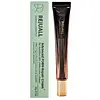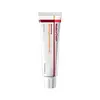What's inside
What's inside
 Key Ingredients
Key Ingredients

 Benefits
Benefits

 Concerns
Concerns

 Ingredients Side-by-side
Ingredients Side-by-side

Water
Skin ConditioningGlycerin
HumectantButylene Glycol
HumectantCyclopentasiloxane
EmollientDimethicone
Emollient1,2-Hexanediol
Skin ConditioningNiacinamide
SmoothingHydrolyzed Collagen
EmollientCyclohexasiloxane
EmollientSodium Hyaluronate
HumectantAcrylates/C10-30 Alkyl Acrylate Crosspolymer
Emulsion StabilisingCetearyl Olivate
Arginine
MaskingHydroxyethyl Acrylate/Sodium Acryloyldimethyl Taurate Copolymer
Emulsion StabilisingSorbitan Olivate
EmulsifyingPolyacrylamide
C13-14 Isoparaffin
EmollientDimethiconol
EmollientSodium Dna
Skin ConditioningCellulose Gum
Emulsion StabilisingAllantoin
Skin ConditioningLaureth-7
EmulsifyingParfum
MaskingAdenosine
Skin ConditioningSorbitan Isostearate
EmulsifyingMelia Azadirachta Leaf Extract
Skin ConditioningMelia Azadirachta Flower Extract
Skin ConditioningPanthenol
Skin ConditioningBetaine
HumectantCoccinia Indica Fruit Extract
Skin ConditioningCorallina Officinalis Extract
Skin ConditioningWater, Glycerin, Butylene Glycol, Cyclopentasiloxane, Dimethicone, 1,2-Hexanediol, Niacinamide, Hydrolyzed Collagen, Cyclohexasiloxane, Sodium Hyaluronate, Acrylates/C10-30 Alkyl Acrylate Crosspolymer, Cetearyl Olivate, Arginine, Hydroxyethyl Acrylate/Sodium Acryloyldimethyl Taurate Copolymer, Sorbitan Olivate, Polyacrylamide, C13-14 Isoparaffin, Dimethiconol, Sodium Dna, Cellulose Gum, Allantoin, Laureth-7, Parfum, Adenosine, Sorbitan Isostearate, Melia Azadirachta Leaf Extract, Melia Azadirachta Flower Extract, Panthenol, Betaine, Coccinia Indica Fruit Extract, Corallina Officinalis Extract
Lactis Proteinum Extract
Skin ConditioningDipropylene Glycol
HumectantHydrogenated Polydecene
EmollientCapric Acid
CleansingCaprylic/Capric Triglyceride
MaskingGlycerin
HumectantGlyceryl Stearate
EmollientPentaerythrityl Tetraethylhexanoate
EmollientNiacinamide
SmoothingCyclohexasiloxane
EmollientCetyl Alcohol
EmollientPolyglyceryl-6 Distearate
EmulsifyingWater
Skin ConditioningDicaprylyl Ether
EmollientVinyldimethicone
Asiaticoside
AntioxidantMadecassic Acid
Skin ConditioningBoric Acid
AntimicrobialMadecassoside
AntioxidantPolypeptide-1
Skin ConditioningHydrolyzed Hyaluronic Acid
HumectantMelaleuca Viminalis Extract
Inula Racemosa Root Extract
Skin ConditioningPalau White Clay Extract
HumectantMacadamia Ternifolia Seed Oil
EmollientDonkey Oil
EmollientHydrogenated Lecithin
EmulsifyingSodium Hyaluronate
HumectantPolyglyceryl-10 Laurate
Skin ConditioningStearyl Alcohol
EmollientBeeswax
Emulsion StabilisingXylitylglucoside
Humectant2-Hydroxyethyl Acrylate
Sodium Acryloyldimethyltaurate Crosspolymer
Emulsion StabilisingJojoba Esters
EmollientAnhydroxylitol
HumectantPolyglyceryl-3 Beeswax
Emulsifying1,2-Hexanediol
Skin ConditioningHydroxyacetophenone
AntioxidantXylitol
HumectantMethylpropanediol
SolventPropanediol
SolventGlucose
HumectantXanthan Gum
EmulsifyingEthoxydiglycol
HumectantDisodium Azelate
Adenosine
Skin ConditioningSorbitan Isostearate
EmulsifyingEthylhexylglycerin
Skin ConditioningSodium Laurate
CleansingCyclodextrin
AbsorbentLauric Acid
CleansingSodium Polyacrylate
AbsorbentPvp
Emulsion StabilisingPvm/Ma Copolymer
Emulsion StabilisingOctyldodecanol
EmollientGlycolide
HumectantCaffeine
Skin ConditioningC12-13 Alketh-9
EmulsifyingCollagen Amino Acids
MoisturisingCeramide EOP
Skin ConditioningResveratrol
AntioxidantArginine
MaskingGlycol
HumectantEctoin
Skin ConditioningTaurine
BufferingHydrolyzed Elastin
EmollientRetinol
Skin ConditioningMaltodextrin
AbsorbentPhytosphingosine
Skin ConditioningSucrose Stearate
EmollientSodium Dna
Skin ConditioningCyanocobalamin
Skin ConditioningGlycine
BufferingGlutamic Acid
HumectantHelianthus Annuus Seed
Skin ConditioningPolyglycerin-3
HumectantTocopherol
AntioxidantArtemisia Vulgaris Extract
Skin ConditioningVanilla Planifolia Fruit Extract
Skin ConditioningOlea Europaea Fruit Oil
MaskingOrange Roughy Oil
Skin ConditioningCitrus Aurantium Dulcis Peel Oil
MaskingLavandula Angustifolia Oil
MaskingCitrus Aurantium Bergamia Fruit Oil
MaskingRosmarinus Officinalis Leaf Oil
MaskingFruit Fly Larva Oil
EmollientCurcuma Aromatica Root Oil
Skin ConditioningAbies Balsamea Bark Oil
MaskingRosa Centifolia Flower Oil
MaskingMarmot Oil
Rosa Damascena Flower Oil
MaskingPelargonium Graveolens Oil
MaskingMyroxylon Pereirae Resin
MaskingLinalool
PerfumingLimonene
PerfumingPinus Mugo Leaf Oil
MaskingLactis Proteinum Extract, Dipropylene Glycol, Hydrogenated Polydecene, Capric Acid, Caprylic/Capric Triglyceride, Glycerin, Glyceryl Stearate, Pentaerythrityl Tetraethylhexanoate, Niacinamide, Cyclohexasiloxane, Cetyl Alcohol, Polyglyceryl-6 Distearate, Water, Dicaprylyl Ether, Vinyldimethicone, Asiaticoside, Madecassic Acid, Boric Acid, Madecassoside, Polypeptide-1, Hydrolyzed Hyaluronic Acid, Melaleuca Viminalis Extract, Inula Racemosa Root Extract, Palau White Clay Extract, Macadamia Ternifolia Seed Oil, Donkey Oil, Hydrogenated Lecithin, Sodium Hyaluronate, Polyglyceryl-10 Laurate, Stearyl Alcohol, Beeswax, Xylitylglucoside, 2-Hydroxyethyl Acrylate, Sodium Acryloyldimethyltaurate Crosspolymer, Jojoba Esters, Anhydroxylitol, Polyglyceryl-3 Beeswax, 1,2-Hexanediol, Hydroxyacetophenone, Xylitol, Methylpropanediol, Propanediol, Glucose, Xanthan Gum, Ethoxydiglycol, Disodium Azelate, Adenosine, Sorbitan Isostearate, Ethylhexylglycerin, Sodium Laurate, Cyclodextrin, Lauric Acid, Sodium Polyacrylate, Pvp, Pvm/Ma Copolymer, Octyldodecanol, Glycolide, Caffeine, C12-13 Alketh-9, Collagen Amino Acids, Ceramide EOP, Resveratrol, Arginine, Glycol, Ectoin, Taurine, Hydrolyzed Elastin, Retinol, Maltodextrin, Phytosphingosine, Sucrose Stearate, Sodium Dna, Cyanocobalamin, Glycine, Glutamic Acid, Helianthus Annuus Seed, Polyglycerin-3, Tocopherol, Artemisia Vulgaris Extract, Vanilla Planifolia Fruit Extract, Olea Europaea Fruit Oil, Orange Roughy Oil, Citrus Aurantium Dulcis Peel Oil, Lavandula Angustifolia Oil, Citrus Aurantium Bergamia Fruit Oil, Rosmarinus Officinalis Leaf Oil, Fruit Fly Larva Oil, Curcuma Aromatica Root Oil, Abies Balsamea Bark Oil, Rosa Centifolia Flower Oil, Marmot Oil, Rosa Damascena Flower Oil, Pelargonium Graveolens Oil, Myroxylon Pereirae Resin, Linalool, Limonene, Pinus Mugo Leaf Oil
 Reviews
Reviews

Ingredients Explained
These ingredients are found in both products.
Ingredients higher up in an ingredient list are typically present in a larger amount.
1,2-Hexanediol is a synthetic liquid and another multi-functional powerhouse.
It is a:
- Humectant, drawing moisture into the skin
- Emollient, helping to soften skin
- Solvent, dispersing and stabilizing formulas
- Preservative booster, enhancing the antimicrobial activity of other preservatives
Adenosine is in every living organism. It is one of four components in nucleic acids that helps store our DNA.
Adenosine has many benefits when used. These benefits include hydrating the skin, smoothing skin, and reducing wrinkles. Once applied, adenosine increases collagen production. It also helps with improving firmness and tissue repair.
Studies have found adenosine may also help with wound healing.
In skincare products, Adenosine is usually derived from yeast.
Learn more about AdenosineArginine is an amino acid that is important for human development. Your body uses is it to produce hair keratin and skin collagen.
As a cosmetic ingredient, Arginine has antioxidant properties and can also help repair damaged skin. This ingredient is derived either synthetically or from animals.
Arginine isn't fungal acne safe when used in the presence of other lipids (fats, fatty acids, oils, esters, etc). Oils and fats occur naturally within the skin, so take caution when using Arginine if you're prone to fungal acne.
Learn more about ArginineCyclohexasiloxane is a type of silicone more commonly known as D6. It is an emollient and solvent.
Cyclohexasiloxane is used to evenly distribute ingredients throughout the product. When applied to the skin, Cyclohexasiloxane evaporates and leaves behind a silky feel.
As an emollient, it can help the skin feel soft and hydrated. It is also used to reduce frizz in hair products.
Learn more about CyclohexasiloxaneGlycerin is already naturally found in your skin. It helps moisturize and protect your skin.
A study from 2016 found glycerin to be more effective as a humectant than AHAs and hyaluronic acid.
As a humectant, it helps the skin stay hydrated by pulling moisture to your skin. The low molecular weight of glycerin allows it to pull moisture into the deeper layers of your skin.
Hydrated skin improves your skin barrier; Your skin barrier helps protect against irritants and bacteria.
Glycerin has also been found to have antimicrobial and antiviral properties. Due to these properties, glycerin is often used in wound and burn treatments.
In cosmetics, glycerin is usually derived from plants such as soybean or palm. However, it can also be sourced from animals, such as tallow or animal fat.
This ingredient is organic, colorless, odorless, and non-toxic.
Glycerin is the name for this ingredient in American English. British English uses Glycerol/Glycerine.
Learn more about GlycerinNiacinamide is a multitasking form of vitamin B3 that strengthens the skin barrier, reduces pores and dark spots, regulates oil, and improves signs of aging.
And the best part? It's gentle and well-tolerated by most skin types, including sensitive and reactive skin.
You might have heard of "niacin flush", or the reddening of skin that causes itchiness. Niacinamide has not been found to cause this.
In very rare cases, some individuals may not be able to tolerate niacinamide at all or experience an allergic reaction to it.
If you are experiencing flaking, irritation, and dryness with this ingredient, be sure to double check all your products as this ingredient can be found in all categories of skincare.
When incorporating niacinamide into your routine, look out for concentration amounts. Typically, 5% niacinamide provides benefits such as fading dark spots. However, if you have sensitive skin, it is better to begin with a smaller concentration.
When you apply niacinamide to your skin, your body converts it into nicotinamide adenine dinucleotide (NAD). NAD is an essential coenzyme that is already found in your cells as "fuel" and powers countless biological processes.
In your skin, NAD helps repair cell damage, produce new healthy cells, support collagen production, strengthen the skin barrier, and fight environmental stressors (like UV and pollution).
Our natural NAD levels start to decline with age, leading to slower skin repair, visible aging, and a weaker skin barrier. By providing your skin niacinamide, you're recharging your skin's NAD levels. This leads to stronger, healthier, and younger looking skin.
Another name for vitamin B3 is nicotinamide. This vitamin is water-soluble and our bodies don't store it. We obtain Vitamin B3 from either food or skincare. Meat, fish, wheat, yeast, and leafy greens contain vitamin B3.
The type of niacinamide used in skincare is synthetically created.
Learn more about NiacinamideSodium DNA is an emerging anti-aging ingredient.
It is created by taking deoxyribonucleic acid (DNA) and purifying it with sodium hydroxide.
The DNA is extracted from several different animal sources, including: calf thymus, the gonadic tissue of a male sturgeon, or herring / salmon sperm.
You have probably seen this ingredient in anti-aging skincare. But what is it?
DNA is composed of nucleotides, or chemical building blocks. Nucleotides include adenine (A), thymine (T), guanine (G), and cytosine (C). Talk about a flashback to biology! Nucleosides are formed from these nucleotides.
The science behind Sodium DNA is based on an ingredient called Polydeoxyribonucleotide or PDRN.
PDRN are DNA fragments mainly extracted from the sperm cells of trout or salmon. Meaning, PDRN can be derived from Sodium DNA.
PDRN consists of chains of nucleotides and nucleosides mentioned above. They can range anywhere from 80 - 2000 pairs.
Studies show PDRN has the following properties:
Most of the research on PDRN has been done using injectable forms. That’s important, because PDRN is a large molecule and doesn’t absorb well through the skin. So if you’re applying it topically, the effects are likely to be much milder.
Still, topical Sodium DNA is emerging as a trendy anti-aging ingredient. It’s generally well-tolerated and offers good biocompatibility with human skin, making it a low-risk addition to most routines.
Further studies are needed to truly confirm this ingredients anti-aging ability (Remember, retinol has decades of research!).
When using this ingredient, is is best to ask a brand about the source of their Sodium DNA. You'll want to find products where the Sodium DNA is sourced from fish. Some Sodium DNA is derived from calf / cow thymus.
Needless to say, this ingredient is not vegan.
Learn more about Sodium DnaSodium Hyaluronate is hyaluronic acid's salt form. It is commonly derived from the sodium salt of hyaluronic acid.
Like hyaluronic acid, it is great at holding water and acts as a humectant. This makes it a great skin hydrating ingredient.
Sodium Hyaluronate is naturally occurring in our bodies and is mostly found in eye fluid and joints.
These are some other common types of Hyaluronic Acid:
Learn more about Sodium HyaluronateSorbitan Isostearate is an emulsifer and cleaning agent. It is created from isostearic acid and sorbitol.
As an emulsifier, Sorbitan Isostearate prevents oils and water from separating.
Due to its isostearic acid base, it may not be safe for Malassezia or fungal acne.
Learn more about Sorbitan IsostearateWater. It's the most common cosmetic ingredient of all. You'll usually see it at the top of ingredient lists, meaning that it makes up the largest part of the product.
So why is it so popular? Water most often acts as a solvent - this means that it helps dissolve other ingredients into the formulation.
You'll also recognize water as that liquid we all need to stay alive. If you see this, drink a glass of water. Stay hydrated!
Learn more about Water